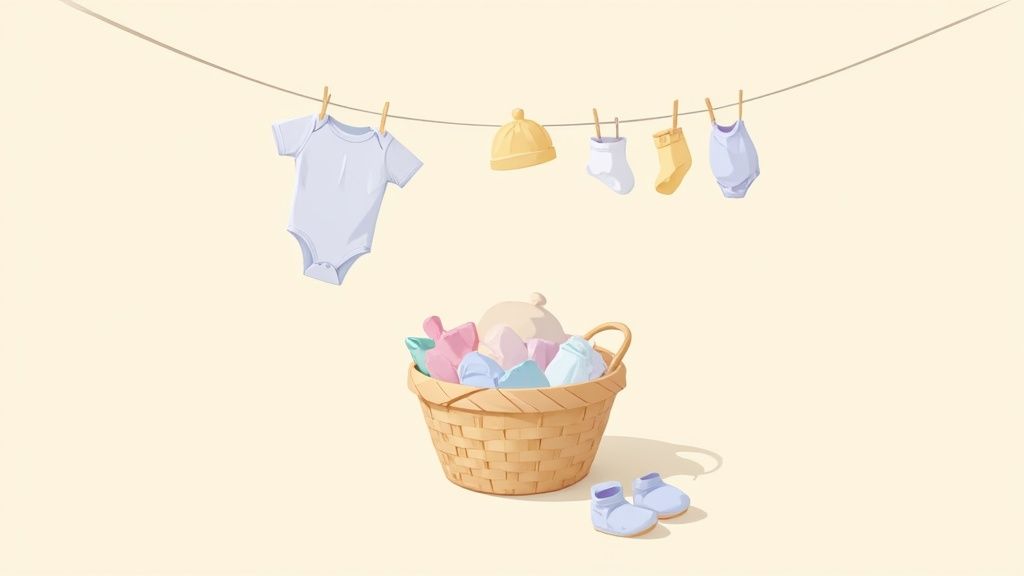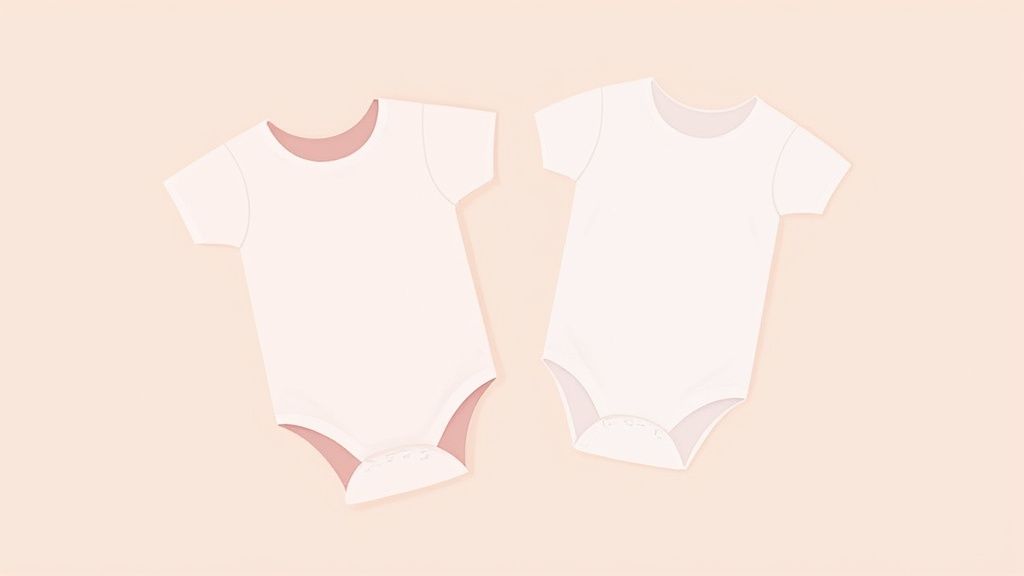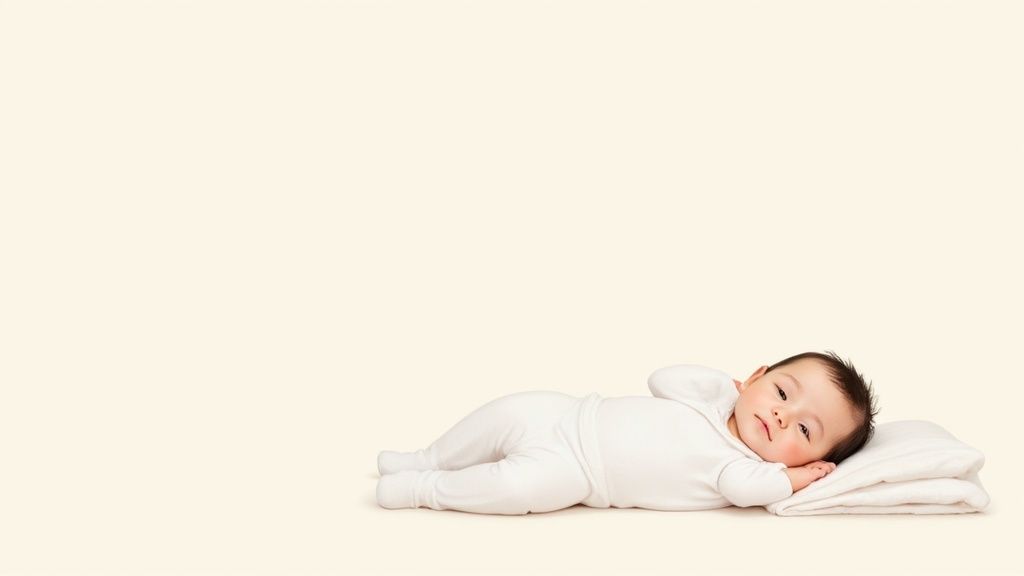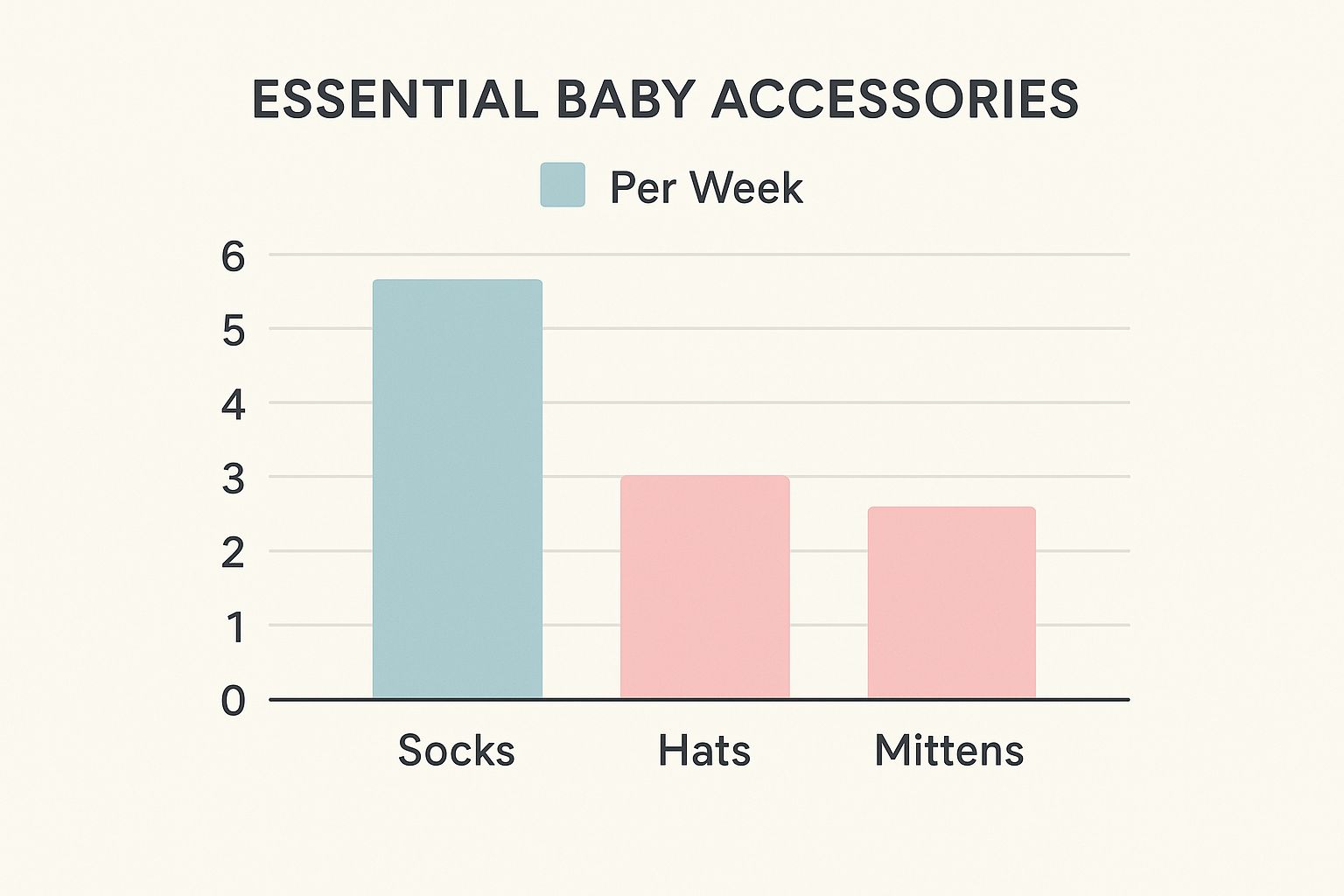
Your Newborn Clothing Essentials List Made Simple
Share
When you're getting ready for a new baby, one of the biggest questions is always about clothes. What do they really need? It's so easy to get carried away.
A good starting point for a newborn clothing list is 4-8 bodysuits, 4-6 sleepers, a few pairs of pants, socks, and a couple of hats. Sticking to these core items will get you through those first few weeks without a closet full of clothes they never wear.
Your Stress-Free Newborn Clothing Checklist
Bringing a newborn home is incredible, but wow, the sheer amount of baby stuff out there can make your head spin. It’s tempting to grab every adorable, tiny outfit you see, but trust me, practicality is your best friend in these early days.
The real goal is to build a small, functional wardrobe that keeps your baby comfy and makes your life easier. Think of it as a "capsule wardrobe" for your little one—just the essential, versatile pieces that cover all the bases. This approach saves you time, money, and a ton of stress.
Why Less Is More at First
Babies grow at a truly astonishing rate. Seriously, they can outgrow the "newborn" size in just a few weeks. Starting with a minimal set of clothes means you won't waste money on things they barely get to wear. You can always buy more later once you get a feel for your baby's size and what your daily routine actually looks like. This minimalist strategy is a cornerstone for many parents when they build their baby registry must-haves.
It's no secret the baby apparel industry is massive. The global market for baby clothing was recently valued at around $227 billion and it's only getting bigger. This shows that parents are definitely investing in their little ones, but they're also getting smarter about it, choosing items that are safe, practical, and truly necessary.
The core principle is simple: focus on function over fashion for the first few months. You need clothes that are easy to put on, can survive endless cycles in the wash, and are super gentle on delicate skin.
Here’s a quick rundown of the absolute must-haves for your initial shopping list:
- Bodysuits (Onesies): The undisputed workhorse of any baby's wardrobe.
- Sleepers (Footed Pajamas): Perfect for sleeping, playing, and pretty much everything in between.
- Pants or Leggings: Great for easy layering over bodysuits on cooler days.
- Socks or Booties: To keep those ten tiny toes warm.
- Hats (Beanies): Crucial for helping newborns regulate their body temperature.
- Swaddles: A lifesaver for helping your baby feel secure and sleep better.
To make it even easier, here's a quick cheat sheet with everything you need to get started.
The Ultimate Newborn Clothing Essentials Checklist
This table breaks down the core items, how many you'll likely need for the first few weeks, and the key features that will make your life so much simpler.
| Item Category | Recommended Quantity | Must-Have Features |
|---|---|---|
| Bodysuits (Onesies) | 6-8 | Lap-shoulder neck, snap crotch |
| Sleepers/Footed PJs | 4-6 | Two-way zippers, built-in mittens |
| Pants/Leggings | 3-5 | Soft, stretchy waistband |
| Socks or Booties | 4-6 pairs | Stay-on cuffs, non-skid soles |
| Beanies/Hats | 2-3 | Soft, breathable fabric (e.g., cotton) |
| Swaddles | 2-4 | Velcro or zipper closures, lightweight |
Focusing on this list will give you a fantastic foundation. You'll have everything you need for diaper changes, spit-up incidents, and cozy naps, without feeling buried in laundry.
Let's Break Down That Baby Clothes Checklist

Okay, you've got the list. Now, let’s get into the why behind each piece. When you understand what each item is actually for, they stop being just tiny, adorable outfits and start becoming the practical tools you’ll rely on every single day.
Think of it this way: we’re taking a tour of a newborn’s wardrobe, but from a purely functional standpoint. Every piece has a job to do to keep your baby comfy, safe, and ready for their main activities: eating, sleeping, and pooping. A lot of pooping.
The Foundation: Bodysuits and Pants
Bodysuits (you’ll probably call them "onesies") are the undisputed champions of your baby's closet. Seriously. They're the baby equivalent of a perfect t-shirt. Their true genius, though, is the snap closure at the crotch—a feature you will thank the heavens for during the 8-12 diaper changes a newborn needs every single day. No more wrestling a whole outfit off for a quick change. Just unsnap, clean, and re-snap.
Pants are the perfect sidekick to a bodysuit. They slide right on for an extra layer of warmth and coziness without being bulky. My advice? Look for pairs with soft, stretchy waistbands that won’t put any pressure on that sensitive little tummy and umbilical cord stump. It's the go-to daily uniform for a reason.
Cozy and Safe Sleepwear
We all know sleep is liquid gold when you have a newborn. The right sleepwear can genuinely make a world of difference for both of you. Sleepers—often the footed pajamas you see everywhere—are brilliant all-in-one outfits that keep your baby snug from their neck down to their toes. Most importantly, they replace loose blankets, which is a cornerstone of safe sleep.
Parenting Pro-Tip: The single most game-changing feature on any sleeper is a two-way zipper. Trust me on this. It lets you zip up from the bottom for those middle-of-the-night diaper changes, keeping your baby’s upper body warm and hopefully, still drowsy.
Sleep sacks are another fantastic invention. They're basically a wearable blanket your baby can't kick off, which means they stay at a consistent, comfortable temperature all night. Figuring out what to wear at night can feel tricky, but our guide on how to dress a baby for sleep breaks it all down for you.
Essential Finishing Touches
Don't overlook the small stuff! These little accessories might seem optional, but they play a huge role in keeping your newborn comfortable and protected.
- Socks or Booties: A newborn's circulatory system is still a work in progress, which is why their hands and feet often feel like little ice cubes. A good pair of socks that actually stays on is worth its weight in gold.
- Hats or Beanies: Babies lose a surprising amount of heat through their heads. A soft, breathable little cap is a must-have, especially in the first few days and for any trips outside in cool weather.
- Scratch Mittens: Those tiny newborn fingernails are like little razors, and babies have zero control over where their hands go. These simple mittens are purely to protect their delicate faces from their own flailing hands.
From the basic bodysuit to the cozy sleep sack, every piece on your list is designed with a newborn’s specific needs in mind. If you focus on getting these functional staples ready, you’ll be perfectly prepared for the sweet, messy, and wonderful reality of life with your new baby.
Choosing the Right Fabrics for Delicate Skin

When you're putting together your newborn's first wardrobe, the fabric is a huge deal. It's not just about what looks cute or feels soft to you—it’s about protecting your baby’s brand-new, super-sensitive skin. Think of it like a delicate little shield that's just getting used to the world.
That's why natural fibers are the hands-down winner for baby clothes. They’re breathable, gentle, and far less likely to cause irritation. They really work with your baby's skin, not against it, making them the perfect first layer.
The Best Fabric Choices for Newborns
As you start looking at labels, you'll notice a few materials pop up again and again as the best picks for comfort and your baby's well-being. These are the fabrics that will keep your little one cozy, no matter the weather.
Here’s what to look for:
- Organic Cotton: This is basically the MVP of baby fabrics. Because it's grown without harsh pesticides or chemicals, it's incredibly soft, breathable, and hypoallergenic. It’s your go-to for everyday essentials like bodysuits and sleepers.
- Bamboo Viscose: Famous for its silky-smooth texture, bamboo is another fantastic choice. It feels amazing, naturally pulls moisture away from the skin, and is great at regulating temperature to keep your baby comfortable.
- Merino Wool: Don't let the word "wool" scare you—merino is unbelievably fine and not the least bit scratchy. It's a true superstar at temperature regulation, keeping your baby warm when it's chilly and cool when it's warm. Perfect for base layers or sleep sacks.
Getting to know the unique perks of each material helps you choose the best fabric for sensitive skin based on the season or your baby's individual needs.
What to Avoid and Why
Knowing what fabrics to skip is just as important as knowing which ones to grab. Synthetics like polyester, nylon, and acrylic often contain chemicals and don't breathe well. They can trap heat and moisture right against your baby’s skin, leading to overheating, rashes, and a fussy, uncomfortable baby.
While a small amount blended into an outer jacket might be fine, anything that directly touches their skin should be natural.
A key trend shows parents globally are prioritizing safety and comfort, making cotton the dominant fabric for newborns. This is driven by a greater awareness of potential irritants like synthetic dyes and materials in traditional clothing. You can discover more insights about this trend on Research and Markets.
For extra peace of mind, keep an eye out for certifications. The GOTS (Global Organic Textile Standard) label, for instance, guarantees the fabric is certified organic from the farm all the way to the finished product. That means you're getting something that's not only gentle on your baby but kinder to the planet, too.
So, How Much Stuff Do I Actually Need? Sizing and Quantities Explained
Alright, let's talk about the two biggest questions that trip up almost every new parent: What size clothes should I buy, and how many of each thing do I need? Get this wrong, and you're either doing laundry constantly or staring at a drawer full of adorable, unworn outfits.
The single best piece of advice I can give you is this: don’t go crazy buying "Newborn" size. It’s a total gamble. Some babies are born big and skip it entirely, while others only fit into it for a week or two. Seriously, they grow that fast.
Cracking the Code on Baby Sizes
Baby clothing sizes are a bit weird because they’re not really about age. It’s all about weight and length. This is where a lot of parents get caught off guard.
Think of it like this: "Newborn" (NB) size is generally for babies up to about 8 pounds. The next size up, "0-3 Months," is usually for babies from 8 to 12 pounds. Since the average baby is born around 7.5 pounds, you can see why the NB size has such a short shelf life.
My go-to strategy? Buy just a handful of essentials in Newborn size for the trip home from the hospital and those first couple of weeks. Put the rest of your budget and energy into the 0-3 Months size. That way, you’re covered either way and won’t have a pile of tiny clothes with the tags still on.
If you want to get really specific, checking out a detailed baby clothing size chart can help you match brand measurements with your baby's estimated size.
Nailing the Numbers: How Many of Each?
Okay, so how many onesies is too many? Honestly, it all comes down to your laundry situation. If you don't mind running a small load every day, you can keep your numbers low. If you're a once-a-week laundry person, you'll need more backups to survive spit-up and diaper blowouts.
Here’s a practical starting point that won't leave you totally overwhelmed:
- Bodysuits/Onesies: 7-8 (a mix of short and long-sleeved)
- Sleepers/Footies: 5-7 (trust me, get the ones with two-way zippers!)
- Pants: 4-5 pairs of soft, comfy pants
- Swaddles: 3-4 so you can have one in use, one in the wash, and a backup
This handy visual breaks down the numbers for some of the smaller accessories.

As a rule of thumb, you'll always need more socks and burp cloths than things like hats. The goal isn't to build a giant wardrobe; it's to have just enough to keep your baby comfy and clean without creating a mountain of laundry for yourself.
To make this even easier, here's a quick reference table to guide your shopping.
Newborn Clothing Quantity and Sizing Guide
This is a great starting point for building your baby's first wardrobe. You can always add more later once you get a feel for what you're reaching for most often!
| Clothing Item | Newborn Size Quantity | 0-3 Months Size Quantity | Seasonal Tip |
|---|---|---|---|
| Bodysuits | 4-5 | 7-10 | For winter, focus on long-sleeved. For summer, short-sleeved. |
| Sleepers | 3-4 | 5-7 | Fleece for cold climates; breathable cotton for warmer weather. |
| Pants | 2-3 | 4-6 | Soft leggings or joggers are perfect for layering. |
| Swaddles | 2 | 2-3 | Lightweight muslin for summer; warmer fleece or flannel for winter. |
| Socks | 4-6 pairs | 6-8 pairs | You'll lose them, I promise. Buy more than you think you need. |
| Hats/Beanies | 1-2 | 1-2 | A simple beanie for the hospital and a sun hat for summer babies. |
Remember, this is just a guide. Friends and family love to gift clothes, so you might find you need to buy less than you think. Focus on getting these core items ready, and you'll be in great shape.
Smart Shopping Strategies for New Parents

Alright, you've got your list of essentials. Now for the fun part: shopping! But before you start clicking "add to cart," let's talk strategy. A little bit of planning goes a long way in building a practical wardrobe for your baby without breaking the bank or losing your mind.
The single best place to start? A baby registry. Think of it as your master plan—a gentle guide for friends and family who are excited to shower you with gifts. It ensures you get the things you actually need (like those 10 sleepers) instead of a closet full of frilly dresses your baby will never wear.
This is especially true today, where shopping is a mix of online and in-person. While specialty stores are still a great experience, the convenience of online shopping is undeniable. It's also worth noting that more and more brands are offering sustainable, eco-friendly collections as parents become more conscious of their environmental footprint. You can see how these market trends are evolving and how it might influence your choices.
New Versus Pre-Loved Clothes
One of the first big questions you'll face is whether to buy everything brand new, go the secondhand route, or accept hand-me-downs. Honestly, there's no wrong answer, but embracing pre-loved clothes has some amazing perks for your budget and the planet.
Babies grow at a frankly astonishing rate, meaning most newborn clothes are barely worn before they're outgrown. Shopping at consignment stores or accepting clothes from a friend can save you a ton of money. It’s also a fantastic way to be sustainable by giving perfectly good items a second chance to be loved.
Don't be shy about accepting pre-loved clothing. The parent community can be incredibly generous, and passing along outgrown baby gear is a time-honored tradition. It's the easiest way to build your baby's wardrobe for free!
Of course, there’s nothing wrong with buying new! It's special to pick out that perfect going-home outfit or invest in high-quality pieces you absolutely love. Most parents find a happy medium: a few special new items mixed with a healthy rotation of secondhand staples.
Features That Make Life Easier
Whether an outfit is new or used, always, always prioritize function over fashion. You'll thank yourself during a 3 a.m. diaper change. Look for clever design features that are made to simplify life with a tiny, wriggly human.
Here are a few non-negotiable, game-changing features to hunt for:
- Two-Way Zippers: An absolute lifesaver on sleepers. You can zip up from the bottom to change a diaper without completely undressing your baby, keeping their chest and arms warm and cozy.
- Lap Shoulders: You know that envelope-style neckline on bodysuits? It's not just a cute design. It lets you pull the entire onesie down over your baby's shoulders during a diaper blowout—a genius trick for avoiding a total mess.
- Built-In Mittens: Many newborn sleepers and gowns come with fold-over cuffs on the sleeves. These double as scratch mittens, protecting your baby's sweet face from their surprisingly sharp little fingernails.
- Soft Seams: Flip a garment inside out before you buy it. Look for flat, non-itchy seams that won’t irritate your newborn’s incredibly sensitive skin.
A Few Common Questions About Baby Clothes
https://www.youtube.com/embed/hmWJTl414ak
Even after you've built what feels like the perfect little wardrobe, you’re bound to have some questions. It’s totally normal! We’ve pulled together a few of the most common things new parents ask to help you feel a little more prepared.
Think of this as your go-to cheat sheet for those little "what do I do now?" moments.
What’s the Best Way to Wash Newborn Clothes?
This is a huge one. A baby’s skin is incredibly sensitive, so the way you wash their tiny clothes actually matters a lot. First thing’s first: always wash new clothes before your baby wears them. This is a non-negotiable step to get rid of any factory dust or lingering chemicals.
When laundry day rolls around, here’s how to keep things gentle and safe for their skin:
- Pick a Gentle Detergent: Look for a liquid detergent that’s free of fragrances and dyes. Many brands make versions specifically for babies or sensitive skin, and they’re your best bet for avoiding irritation.
- Wash Theirs Separately: It might seem like extra work, but washing baby’s clothes in their own load is a smart move. It keeps residue from the stronger detergents you use on your clothes from getting onto their things.
- Ditch the Fabric Softener: Liquid softeners and dryer sheets are loaded with chemicals and scents that are just too much for a newborn’s skin. Trust us, their clothes will be perfectly soft without them!
Should I Buy Gender-Neutral Baby Clothes?
Honestly, it's one of the most practical things you can do. Going with gender-neutral clothes isn't just a trend—it's a seriously smart strategy that simplifies everything. It makes saying "yes!" to hand-me-downs so much easier.
A flexible, neutral wardrobe is a massive money-saver. If you think you might have more kids down the road, you can reuse every last piece, no matter the gender, basically cutting your future baby-clothing budget in half.
Colors like soft grays, creamy whites, sage greens, and buttery yellows are classics for a reason. They look great on everyone and make it simple for friends and family to buy gifts before the baby even arrives.
How Do I Know if My Baby Is Too Hot or Too Cold?
This can feel like a total guessing game at first, but there's a simple trick that works every time. The golden rule is to dress your baby in one more thin layer than what you're comfortably wearing yourself.
The real key is knowing where to check their temperature. Don't use their hands or feet as a guide! A baby's circulatory system is still a work in progress, so their little hands and feet often feel chilly even when they're perfectly cozy.
Instead, feel the back of their neck or their tummy.
- If their skin feels warm and dry, you've nailed it. They're comfortable.
- If it feels sweaty or hot, they're too warm. Time to peel off a layer.
- If it feels cool to the touch, they might need an extra light layer, like a swaddle or blanket.
This quick check removes all the mystery and helps keep your little one safe and comfortable.
At Little Venture Co., we design our bamboo sleepwear and daywear to be as gentle as it is beautiful, perfect for your baby's delicate skin. Explore our collections and wrap your little one in comfort and inspiration.
Shop Our Ultra-Soft Bamboo Collections at Little Venture Co.
